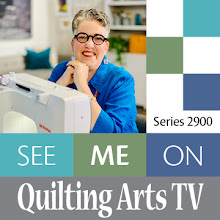“Duel” by Susan Brubaker Knapp
Copyright 2017 – 32x26"
White cotton fabric; black, white and red threads; ink; wool batting.
Thread sketched, free-motion quilted, hand embroidered.
This is my entry for Studio Art Quilt Associates’ exhibition called “Guns: Loaded Conversations.” The juried exhibition examines America’s “heritage and current cultural norms” and encourages civil conversation about ways to reduce our gun violence.
The deadline is tomorrow, Oct. 31, so I am just getting in under the wire! I’d had this piece in mind for the exhibition for some time, but did not have time to work on it until I got back from teaching at the New Zealand National Quilt Symposium earlier in the month.
It is based on a sketch I made of Alexander Hamilton and Aaron Burr and their dueling pistols, and is thread sketched (on the surface and through a layer of interfacing for stability) in black thread, then quilted and hand embroidered (the red blood and wound). There is also some hand stippling (dots) and cross-hatching (crossed lines) using a Micron Pigma Pen to add extra dimension and shading.
Artist’s Statement: The 1804 duel between Alexander Hamilton and Aaron Burr took the life of one of our most brilliant founding fathers, and destroyed the career of a vice president and Revolutionary War hero. I remember learning about dueling in elementary school and being in total disbelief about the stupidity of it. Shooting someone in a bizarre social ritual over a disagreement or a slight to one’s honor? Even more shocking is that more than 200 years later, Americans are still shooting each other at record pace, but with far more lethal weapons, and that we seem unable to find any real solutions to the violence.
Here is the text from SAQA’s Call for Entries for the exhibition:
Americans have owned and used guns throughout the history of our nation. Whether used for hunting, sport, protection, commerce or collection, guns have been a part of our shared heritage and culture. Today we find ourselves living in a society in which gun violence feels commonplace. Gun violence has taken its toll all over the world, in many different ways. An enormous divide exists between people who cherish their heritage of gun ownership and others who are concerned that guns contribute to the rising tide of gun violence.
If we are to find ways to reduce injury and death from gun violence, we must find a way to bridge this divide and talk openly and honestly about potential solutions while at the same time respecting legitimate uses for firearms. This challenging problem continues to be complicated by polarizing political positions, various underlying causes of violence in today’s society, emotional responses, and the desire to enjoy shooting for sport, hunting, or protection as well as maintaining family traditions. Layered on top of these competing and conflicting opinions are the forces of both sides' sophisticated lobbying efforts and a lucrative marketplace.
Artists have been a catalyst for difficult societal conversations throughout history, here and abroad. This ever-broadening divide between opposing opinions on this subject will require creative thinking and an evaluation of a wide host of possible solutions, if we are to find ways to reduce gun violence. Artists are encouraged to explore the heritage and current cultural norms reflected in gun ownership; to consider how their personal experience with guns may influence their opinions; to find ways to engage those of differing opinions to listen to each other in a thoughtful manner; and to investigate and encourage community initiatives that may inspire action in seeking solutions. Truly valuable conversation requires looking at all sides of a subject, and considering those differing viewpoints will be essential in building a bridge over that divide.
PREMIERE LOCATION
San Jose Museum of Quilts & Textiles
San Jose, California
April 22 - July 15, 2018























































































